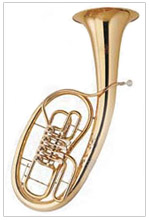- Wagner tuba
Infobox Instrument
color1=#FFD700
color2=#FFEC8B
name=Wagner Tuba
names=en: "Wagner tuba", de: "Wagnertuba"
classification=
*Wind
*Brass
*Aerophone
related=
*Horn (French horn)
*Tuba The Wagner tuba is a comparatively rare
brass instrument that combines elements of both the horn and thetuba . It was originally created forRichard Wagner 'sopera tic cycle "Der Ring des Nibelungen ". Since then, other composers have written for it, most notablyAnton Bruckner , in whose Symphony No. 7 a quartet of them is first heard in the slow movement in memory of Wagner. Theeuphonium is sometimes used as a substitute when a Wagner tuba cannot be obtained.Wagner was inspired to invent this instrument after a brief visit to
Paris in1853 , when he visited the shop ofAdolphe Sax , the inventor of thesaxophone . Wagner wanted an instrument that could intone the Valhalla motif somberly like atrombone but with a less incisive tone like that of a horn. That effect was obtained by a conical bore (like a horn) and the use of the horn mouthpiece (tapered as opposed to a cup mouthpiece such as on a trombone). The instrument is built with rotary valves which, like those on the horn, are played with the left hand.The Wagner tuba nominally exists in two sizes, tenor in B-flat and bass in F, with ranges comparable to those of horns in the same pitches while being less adept at the highest notes. Several
20th-century and later manufacturers have, however, combined the two instruments into a double Wagner tuba in B-flat and F. Wagner tubas are normally written astransposing instrument s, but the notation used varies considerably and is a common source of confusion—Wagner himself used three different and incompatible notations in the course of the "Ring", and all three of these systems (plus some others) have been used by subsequent composers. An additional source of confusion is the fact that the instruments are invariably designated in orchestral scores simply as "tubas", leaving it sometimes unclear as to whether true tubas or Wagner tubas are intended (for example, the two tenor tubas in Janáček's "Sinfonietta" are sometimes wrongly assumed to be Wagner tubas).The sound of the Wagner tuba is mellower than that of the horn and sounds more distant, yet also more focused. Bruckner generally uses them for pensive melodic passages at "piano" to "pianissimo" dynamics. They can hold their own in a "forte" tutti, of course, but Bruckner generally gives them sustained tones rather than melodic motifs in such passages. In Bruckner's Eighth and Ninth Symphonies, the four Wagner tubas are played by four players who alternate between playing horn and Wagner tuba, which is the same procedure Wagner used in the "Ring". This change is simplified by the fact that the horn and Wagner tuba use the same mouthpiece.
Where on the orchestral score the Wagner tubas are placed depend on who plays them. If they are played by players who are also playing horn, the staves for the Wagner tubas logically go below those of the horns and above the trumpets. If they are played by players who are not also playing horn, they are placed below the trombones, above the regular tuba, which is then called a "contrabass tuba."
The name "Wagner tuba" is considered problematic, possibly incorrect, by many theorists.
Kent Kennan says they could go by just about any other name since "they are really modified horns." [Kent Kennan & Donald Grantham, "The Technique of Orchestration". New York: Prentice Hall (1990): 348. "It has frequently been pointed out that the name "tubas" is a misnomer inasmuch as they are really modified horns."] But since they have been called "Wagner tubas" for so long, changing to a more sensible name is unlikely.Besides Wagner and Bruckner, other composers who've written for the instrument include
Béla Bartók ,Stephen Caudel , Andrew Downes,Felix Draeseke ,Alexander Kaloian ,Elisabeth Lutyens ,Michael Nyman ,Ragnar Søderlind ,Arnold Schoenberg ,Richard Strauss ,Igor Stravinsky ,Edgard Varèse andSofia Gubaidulina .References
* Raymond Bryant, Anthony C. Baines, John Webb, "Wagner tuba" "The New Grove Dictionary of Music and Musicians", Volume 26, ed. Stanley Sadie. London: Macmillan Publishers Limited, 2001
External links
* [http://www.wagner-tuba.com The Wagner Tuba, history, composers and Edel Rhapsody (wagner-tuba.com)]
* [http://www.draeseke.org/essays/wmtuba.htm Felix Draeseke and the Wagner Tuba]
* [http://www.old.kglteater.dk/ringen/uk/om_ringen_musikken_artikel_Wagnertubaen.html THE WAGNER TUBA – the instrument that only existed in Wagner’s imagination]
* [http://www.compositiontoday.com/sound_bank/wagner_tuba/all.asp Wagner Tuba sound samples]
* [http://www.celesteh.com/music/tuba Evolution, Physics and Usage of the Wagner Tuba]
Wikimedia Foundation. 2010.
